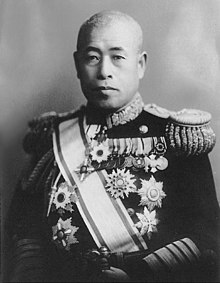
Back Isoroku Yamamoto Afrikaans Isoroku Yamamoto AN إيسوروكو ياماموتو Arabic ايسوروكو ياماموتو ARZ İsoroku Yamamoto Azerbaijani Isoroku Yamamoto BCL Ісароку Ямамота Byelorussian Исороку Ямамото Bulgarian Isoroku Yamamoto Breton Isoroku Yamamoto Catalan
Isoroku Yamamoto | |
|---|---|
 Admiral Yamamoto, c. 1940 | |
| Native name | 山本 五十六 |
| Born | April 4, 1884 Nagaoka, Niigata, Empire of Japan |
| Died | April 18, 1943 (aged 59) near Panguna, Bougainville, Territory of New Guinea |
| Buried | Tama Cemetery, Tokyo[1] |
| Allegiance | Empire of Japan |
| Service | Japanese Navy |
| Years of service | 1904–1943 |
| Rank | |
| Commands | Isuzu, Akagi, 1st Carrier Division, Naval Aviation Bureau, 1st Fleet, Combined Fleet, 1st Battleship Division[2] |
| Battles / wars | |
| Awards | |
| Alma mater | Imperial Japanese Naval Academy Harvard University |
| Spouse(s) |
Reiko Mihashi (m. 1918) |
| Other work | Vice-Minister of the Navy |
Isoroku Yamamoto (山本 五十六, Yamamoto Isoroku, April 4, 1884 – April 18, 1943) was a Marshal Admiral of the Imperial Japanese Navy (IJN) and the commander-in-chief of the Combined Fleet during World War II. He commanded the fleet from 1939 until his death in 1943, overseeing the start of the Pacific War in 1941 and Japan's initial successes and defeats before his plane was shot down by U.S. fighter aircraft over New Guinea.
Yamamoto graduated from the Imperial Naval Academy in 1904 and served in the Russo-Japanese War, where he lost two fingers at the Battle of Tsushima. He later studied at Harvard University in the United States and was appointed naval attaché to the Japanese embassy in Washington. His experiences convinced him that naval power depended on access to oil and industrial capacity, and that Japan thus had little hope to defeat the U.S. in a war. He was one of the first naval leaders to conclude that naval aviation and aircraft carriers would play a decisive role in any future conflict. In 1936, Yamamoto was appointed navy vice minister, and opposed Japan's alliance with Germany in the Tripartite Pact of 1940. In 1939, he was appointed commander-in-chief of the Combined Fleet, and was tasked with creating a strategy for war with the U.S.; Yamamoto favored a surprise attack, which he carried out at the start of the war with an attack on Pearl Harbor in December 1941.
In the early months of the war, the Japanese fleet scored a series of decisive naval victories. These gains were halted at the Battle of Midway in June 1942, in which four Japanese carriers were sunk. Yamamoto committed to the defense of the Solomon Islands in the Guadalcanal campaign, but was unable to prevent their capture. In April 1943, Yamamoto was killed after American code breakers intercepted his flight plans, enabling the United States Army Air Forces to shoot down his aircraft.
- ^ Ryfle & Godziszewski 2017, p. 294.
- ^ Yamamoto Isoroku Archived April 14, 2016, at the Wayback Machine. navalhistory.flixco.info
- ^ Yamamoto Isoroku. navalhistory.flixco.info